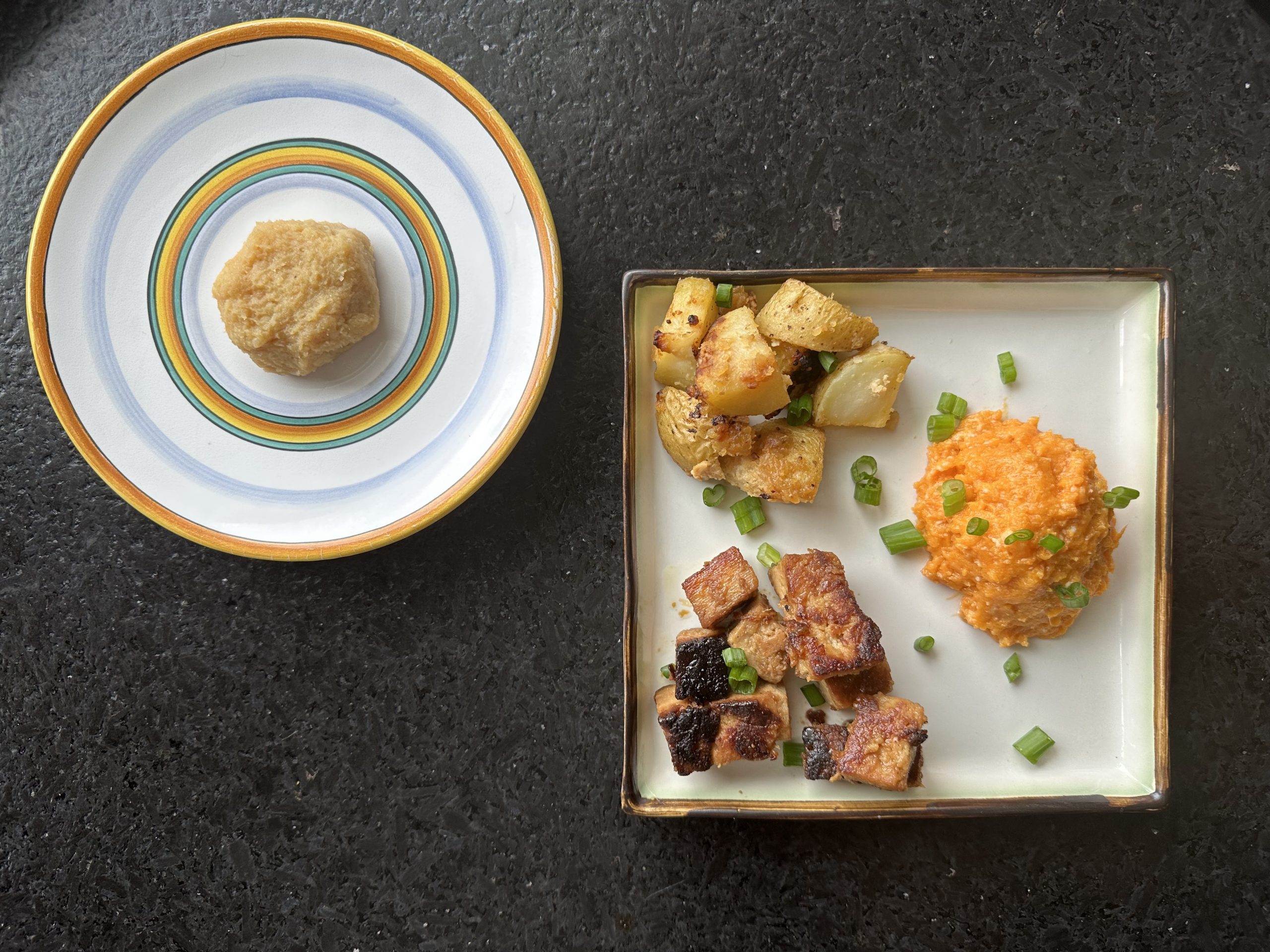Above: a trio of white miso dishes: fried tofu with ginger and garlic, miso butter baked potatoes, and mashed sweet potatoes with miso butter. On the round plate is a dollop of white miso.
The Great White Miso
Miso is best known for miso soup, and I’ve always enjoyed a good bowl. But there is more to this salty fermented soybean paste than what is in the bowl that precedes your sushi order. Miso is as versatile as mayonnaise, and comes in a spectrum of colors, each with different formulations and properties.
Darker shades of miso have more flavor, with red miso, which is fermented with barley, having the deepest flavor. This makes red miso the usual choice in miso soup. White miso, made from a combination of fermented soybeans and rice, is the mellowest on the spectrum. It is so mild and sweet that you can eat it straight off a spoon. I had never tried white miso until I needed some for a white miso-glazed baked salmon recipe.
The recipe is simple. Mix the juice of a lemon with a quarter cup of white miso, and spread the resulting slurry on the fish. Then bake, and sprinkle with sesame seeds. After that I was hooked on the mild but rich flavor of white miso. And since I had most of a container of white miso left over after making the recipe, I began searching for ways to use it.
I found that adding white miso to complex dishes imparts a nice dose of umami without making it obvious what is behind it. It simply makes the foods taste better without making them taste like miso.
As I explored ways to use white miso, it seemed as though every innovation I came up with had already been discovered by vegans. When I added it to a batch of pho, I did not have high hopes. It seemed like such an incongruous combination, but I had the pho and I had the white miso, so why not? To my surprise it greatly improved the pho, adding a rich foundation of umami without altering the characteristic aroma and flavor. I was equally shocked to Google “miso pho” and find a cluster of vegan pho recipes that take advantage of miso to compensate for the lack of meat.
Next, I added some white miso to a marinara sauce, assuming again that I was breaking new ground. The kids, who generally frown on any alteration to the basic red spaghetti sauce, chose the white miso marinara in a side-by-side comparison. This rendition also exists online, and is again a vegetarian favorite. Clearly the meat-free community has caught onto the meaty qualities of miso, and embraced it as a secret weapon. But that hasn’t stopped me from adding miso to meat dishes.
To add miso to a soup or sauce, it is imperative to get out all the lumps, because not everyone enjoys it by the mouthful the way I do. Pour a small quantity of the soup or sauce into a little bowl and mix the miso into that until it’s totally smooth. Then add the mixture back to the pot or pan, and stir it in.
Adding white miso to a complex dish is a slick way to improve a recipe without altering its vibe. When adding it to simpler foods, I prefer mixing it with butter first. Simply mush together equal parts of white miso and softened butter, and you’ve got a mild, cozy paste that’s great on rice, mashed potatoes, roasted roots and other starchy foods. You can even lather it onto bread. Adding lemon, garlic and black pepper to miso butter creates a tangy, all-purpose sauce that I like on freshly cooked pasta, steamed vegetables, meat and mashed sweet potatoes.
If you don’t like butter you can substitute olive oil for the butter in this concoction. And the proportions of all the ingredients are flexible. It’s all to taste. If a batch doesn’t taste miso-y enough, add more. But to get you into the ballpark, here are some basic proportions. After that, a recipe for white miso tofu, with ginger and garlic.
White Miso Butter
Only the first two ingredients are mandatory. After that it’s up to you and the context to which you will apply this paste. For plain rice I would stick to just miso and butter. For potatoes I would skip the lemon juice but keep the garlic and black pepper. For meat, fish, vegetables and pasta, use the whole list.
¼ cup white miso
¼ cup softened butter
2 tablespoons lemon juice
1 teaspoon pressed garlic
¼ teaspoon black pepper
White Miso Tofu
1 pound tofu, cut into inch-cubes, with excess water drained or wiped off
¼ cup frying oil
For the marinade
1/3 cup white miso
1 tablespoon lime juice
3 tablespoons soy sauce
2 tablespoons Mirin or other rice wine (if you can’t find it, don’t sweat it)
3 tablespoons brown sugar
2 tablespoons honey
1 tablespoon mashed ginger
1 tablespoon mashed garlic
Mix the marinade ingredients in a medium sized bowl. Add the tofu and marinate for up to two days. Pan-fry the tofu on medium heat, gently turning to brown on all sides.
